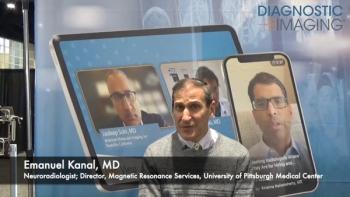
Standardized chemoembolization protocol boosts liver cancer patient survival
Results from the largest and longest trial of its kind suggest that patients with intermediate and advanced hepatocellular carcinomas who undergo systematic treatment with three chemotherapeutic agents and arterial embolization plus imaging follow-up have better survival rates than those who undergo nonstandardized chemoembolization regimes.
Results from the largest and longest trial of its kind suggest that patients with intermediate and advanced hepatocellular carcinomas who undergo systematic treatment with three chemotherapeutic agents and arterial embolization plus imaging follow-up have better survival rates than those who undergo nonstandardized chemoembolization regimes.
That was the message delivered Sunday at the 2008 RSNA meeting by principal investigator Dr. Eleni Liapi, an interventional radiologist at Johns Hopkins University.
The treatment of patients with nonresectable liver malignancies using transcatheter arterial chemoembolization (TACE) has achieved widespread popularity worldwide. The type of drug and treatment management protocols used, however, can also be just as diverse.
This lack of standardized TACE protocols could significantly affect treatment outcomes, according to Liapi.
Retrospectively from 1996 to 2000 and prospectively from 2001 to 2007, Liapi and colleagues enrolled 347 patients with unresectable HCC who were 65.6 years old in average. All patients underwent a standardized protocol:
- MRI and/or CT at baseline
- An average of three TACE sessions spaced out by about 80 days
- Clinical, biochemical, and imaging evaluations before each TACE session
- Imaging follow-up at four to six weeks after each TACE session
The Hopkins TACE protocol included doxorubicin, cisplatin, and mitomycin-C mixed with lipiodol followed by embolization with polyvinyl alcohol or microspheres, avoiding complete vessel occlusion. Researchers evaluated disease status before and after treatment and measured tumor size using the Response Evaluation Criteria in Solid Tumors (RECIST).
The investigators found that patients who completed the standardized treatment and follow-up protocol had stable liver disease and effective tumor control. In addition, these patients achieved average survival rates of nearly two years.
"Achieving 20 months median survival in a population that had 3% to 4% vascular invasion is commendable and quite a bit different from a lot of the other reports on survival from patients who have vascular invasion," said session chair Dr. William S. Rilling, an associate professor of radiology and surgery at the Medical College of Wisconsin.
TACE has already been proven as an effective treatment for patients with unresectable HCC, according to Liapi. But the comprehensive standardized protocol used at Hopkins for over a decade has been shown to bolster its effectiveness. Controlled randomized studies comparing different protocols would be ideal to validate the best treatment.
These are hard to come by, however, mostly due to ethical considerations, Liapi said.
"Right now, we are at the stage that we cannot perform that. So our best bet would be to just present as many patients as we can and show how these patients did over time," she said.
Newsletter
Stay at the forefront of radiology with the Diagnostic Imaging newsletter, delivering the latest news, clinical insights, and imaging advancements for today’s radiologists.




























